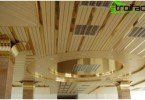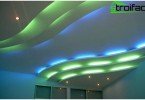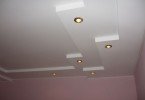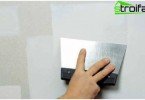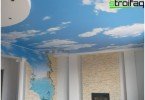DIY ceiling repair
In some ways, the ceiling can be called the “face” of any room, so for any repairs it needs to be put in order, no matter how you would like to avoid this very time-consuming procedure. Whether it is possible to repair the ceiling with your own hands or if you need to invite real professionals, depends only on your plans. If they include a simple refreshment of the ceiling with a new layer of whitewash, a banal plywood of ceiling wallpapers, painting the ceiling in one color or fixing minor defects, then of course you can do it yourself. Appeals to the construction company cannot be avoided if you are planning global changes in the design of the ceiling, including the installation of complex structures, as well as the creation of interesting light and color schemes. In this article we will talk about the features of the repair of various ceilings, from simple whitewashed and ending with tension and suspension structures.
Content
- Ways to repair a whitewashed ceiling
- Eliminate staining defects
- Technology for repair of suspended ceilings
- False Ceiling Repair
- “Flooded!” – Your actions
Ways to repair a whitewashed ceiling
Whitewashed ceilings confident steps are a thing of the past. Fewer and fewer people give them preference; nevertheless, modern technologies allow creating more interesting designs. Before you start repairing a whitewashed ceiling, you must carefully remove the old coating. Lime is removed from the ceiling in two ways:
- Dry, in this case it is possible to remove the entire coating faster and cleaner, but at the same time it will scatter in different directions.
- Pre-wetting the surface of the ceiling. Weighted lime soaked in water will fall strictly down, but the complexity of the job will increase significantly. The fact is that the wet whitewash is lagging behind in small islands and therefore it will be necessary to make great efforts to remove the entire coating without a trace.
And that is not all. Even if it seems to you that the ceiling is completely clean, do not trust your eyes. Be sure to rinse the entire surface with clean, warm water and detergent. In this case, the solution must be replaced as often as possible – the less dust and dirty stains remain, the longer you will not return to the issue of repairing the ceiling.
Important: If there were any stains on the whitewashed ceiling, for example, grease or rust, then you must also remove them on the ceiling plates, otherwise they will protrude again and again on the surface.
After the ceiling is as thoroughly dried as washed, you can proceed to the primer. This step is necessary in order to achieve better adhesion between whitewashing and the ceiling surface. Again we wait for the primer to dry completely.
It is good if the ceilings are already aligned. If not, this must be done before applying a new coat of whitewash. With a difference in height not exceeding 50 mm, you can do it by applying gypsum in several layers, while the thickness of each should not exceed 20 mm. Particular attention should be given to cracks. Small ones can simply be carefully coated with a solution of gypsum, but large ones must first be sealed with mesh material. A sickle is well suited, but instead you can use ordinary medical gauze, folded in two or three layers.
Interesting: Serpyanka is an adhesive reinforcing tape that adheres to plaster or putty..
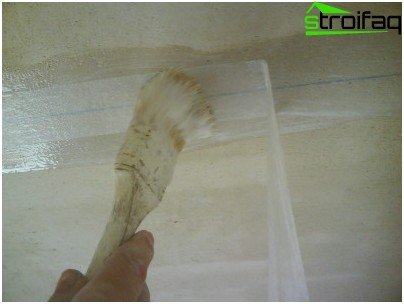
Ceiling alignment: Serpianka must be glued to large cracks
Eliminate staining defects
To paint the ceilings you need to prepare no less carefully than for whitewashing. It only seems that the painted coating is much stronger, in fact the slightest flaw can lead to peeling of the paint and the appearance of cracks.
There are three ways to remove old paint from the ceiling:
- Thermal, that is, using a building hair dryer. When heated to a very high temperature, the paint lags behind surfaces more easily..
- Mechanical is sanding with coarse-grained emery paper, grinding with the help of special devices, ordinary scraping with metal brushes. Typically requires significant effort..
- Chemical – dissolving paint with various solvents.
After removing paint, the process of preparing the ceiling surface for applying a new coating is similar to that recommended by us for whitewashing.
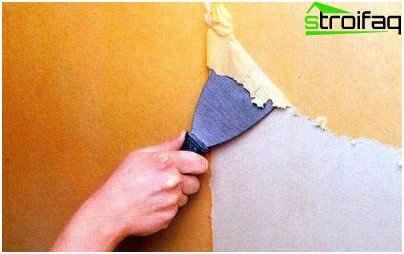
Removing paint from the ceiling mechanically
Sometimes after painting, for one reason or another, the coating is cracking. If there are few cracks and the paint does not crumble along their edges, this problem can be solved with sealant. Carefully, using a gun, fill it with a crack, and remove residuals along the edges with a spatula dipped in cold water. After that, it is necessary to clean the surface with sandpaper and cover with a layer of paint, which was previously used.
Technology for repair of suspended ceilings
We will not talk here about how to make a stretch ceiling correctly, since its installation is quite complicated and more often performed by professionals, and not by our own efforts. Consider only the main defects that may appear on such a coating, and methods for their elimination.
The most common damage to suspended ceilings is considered to be cuts resulting from throwing up an object with sharp edges or when installing new cabinets. If the cut length does not exceed 200 mm, then immediately it is necessary to seal it with tape so that during the preparatory work the edges do not creep. Next, we need two small pieces of soft plastic. Disposable tableware is very suitable for this. Cutting from them two segments 15-18 mm long, glue them to the ends of the cut.
Tip: to mask the seam on the sealed cut, you can apply, a false grill for ventilation or install another ceiling lamp.
It is very good if the canvas stretch ceiling is damaged in the corners of the room. In this case, the damaged area is removed, and the material is heated and again stretched to the corner of the room, as a result of which the ceiling takes on its original appearance.
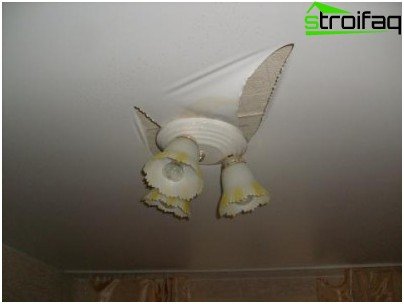
Such a gap in the stretch ceiling is unlikely to be eliminated. Exit – replacing the ceiling
If the cut length exceeds 200 mm, then there is no question of repairing the ceiling with your own hands – only replacing the coating, as in the case of burning it.
When the ceiling sags, the only way out is to haul the material. Most often, the masters who install the coating are to blame for such a nuisance, so feel free to contact the naughty company, of course, if you did not pull the canvas yourself.
Her one common nuisance is the flood of the ceiling with neighbors from above. Do not worry too much in such a situation, in most cases, after draining the water through a small hole and heating the canvas to the required temperature, the coating returns to its previous form.
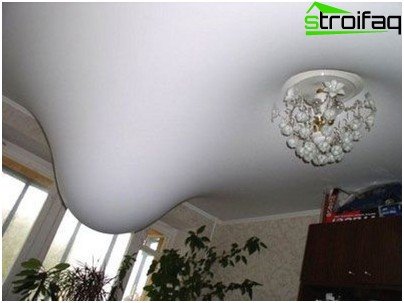
Such a ceiling defect that occurs after the gulf from above is easily eliminated.
False Ceiling Repair
Today, suspended ceilings are leaders in the construction market. After all, they successfully mask all the flaws of the original ceiling, are easily installed and repaired if necessary. If only one or several modules is damaged or deformed, then only they are removed and replaced with new ones. In the event that the skew is insignificant, it can be eliminated by alignment, and the straightened module can be reinstalled. Be sure to find out the cause of the damage. Maybe it’s a bay from above or high humidity in the room.
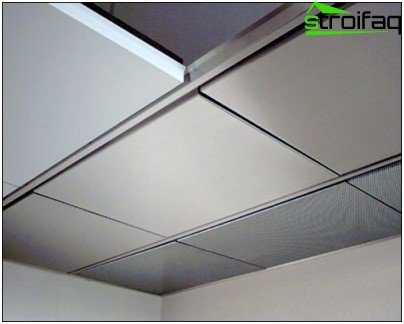
A significant advantage of suspended ceilings is that when a defect in one of the modules is displayed, it can be replaced without disassembling the entire ceiling.
If the entire ceiling is sagging, then most likely the case is the frame guides: either the material from which they are made is too soft, or the distance between the fasteners is incorrectly selected. Such repairs are much more complicated, you will have to remove all the modules, replace the sagging rails or increase the number of fasteners.
Only a combination of factors such as proper preparation, installation with exact observance of technology and careful handling of the ceiling during operation can guarantee the long service life of any ceiling coating and avoid repair.


